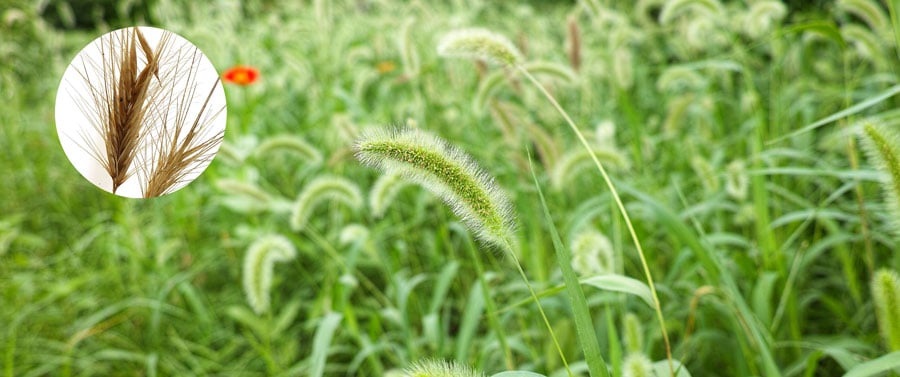If you've spent at least one summer in Idaho, then you are well aware of a particular annoying weed that grows rampant across the West. Scientists refer to it as Bromus Madritensis, us non-Ph.D. folks call it foxtail grass, and it's more than a nuisance. It'll stick to your socks and cause a poke in your shoes, but it could also be deadly to your dog.
The Dangers of Foxtail Grass
Foxtail grass may seem harmless when it pops up—it'll look green and grow close to the ground, showing no signs of the dangerous seeds that are coming. Once the seeds develop, they quickly dry out (particularly in our rainless summers here in Idaho). Once the foxtail seed awns dry out, they harden into sharp, barbed spears, designed specifically to burrow deep into the ground and propagate the plant.
Foxtail grass seed awns are the reason this ferocious weed grows so prolifically: the barbs attach like glue to animals and humans as they pass through the low-lying brush, transporting the seed to new soil. Once the seed is at its new destination, it will work its way into the soil and start a new patch of foxtail grass. But what happens when a seed starts burrowing into something other than soil— for instance, your dog?
Foxtail seeds are a common summer danger to dogs, even cats, in the Western United States because the seeds will lodge themselves in the eyes, ears, mouth, nose, and skin. The seeds don't break down in a dog's or cat's digestive tract or body, and because of this, they can cause significant issues, infections, or even death.
Know the Signs
When you head out to the foothills this summer or take your dog on a camping trip, it's vital that you give him or her a thorough once-over with a brush and your careful eyes to look for ticks, pests, and foxtail seeds. But if you miss one, you should know what to look out for and how to keep your pet safe.
An embedded foxtail grass seed will cause:
- Abscesses
- Swelling
- Discharge
- Signs your pet is in pain
You may notice that your dog is scratching his ear constantly or favoring one of her legs. Maybe you'll see that your dog's eyes are watering all day or that he keeps sneezing. These are all indications that there may be a foxtail seed lodged in your dog's body somewhere. Since dogs have a tendency to lead with their nose and sniff out new territory, the face (eyes, ears, and nose) are often where you'll find a rogue seed.
Watch for these signs:
- Limping or favoring a foot: A seed may be lodged in your dog's paw if you notice licking, swelling, or limping
- Head shaking or tilting: Does your dog look quizzical? Maybe she's asking, "Hey, why aren't you taking this foxtail grass seed out of my ear?"
- Discharge, swelling, or redness: If your dog is pawing an area that looks irritated, take your dog to the vet immediately. An abscess may be forming already in this case.
Remember, once a foxtail has embedded itself into your dog's skin, it will take a professional to remove it, including anesthetic and a surgical procedure by your veterinarian. Never attempt to remove an embedded foxtail yourself, since you may cause additional infection, pain, and suffering for your dog.
Prevent your dog from encountering foxtail by keeping your lawn and garden weed-free and avoiding areas where you see this invasive grass growing. Inspect your dog frequently, and if you have any questions or concerns, don't hesitate to contact us right away!
